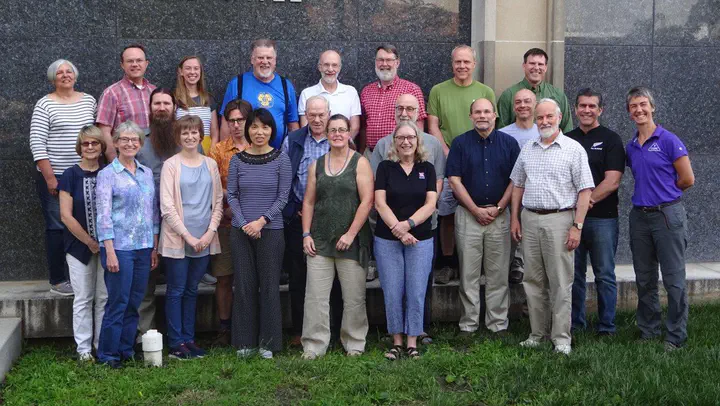2019 NCCC170 Annual Meeting
University of Illinois, Urbana-Champaign

Thursday, June 20, 2019
8:00 AM
Registration, check-in, coffee, juice, snacks
8:30 AM
Welcome
Chris Harbourt, CEO, AirScout, Inc.
Chris Harbourt, CEO, AirScout, Inc.
8:45 AM
Hierarchical modeling of structural coefficients for heterogeneous networks with an application to animal production systems
Nora Bello*, K. Chitakasempornkul, A. Jager, Kansas State University
Guilherme Rosa, University of Wisconsin-Madison
Understanding the interconnections between performance outcomes in a system is increasingly important for integrated management. Structural equation models (SEM) are a type of multiple-variable modeling strategy that allows investigation of directionality in the association between outcome variables, thereby providing insight into their interconnections as putative causal links defining a functional network.
More...
9:20 AM
Generalized Additive Mixed Modeling of Total Transport Losses of Market-Weight Pigs
Guilherme Rosa*, University of Wisconsin-Madison
The objective of this study was to investigate factors associated with total transport losses (TTL) of market-weight pigs using a Generalized Additive Mixed Model (GAMM). The dataset was provided by Iowa Select Farms (Iowa Falls, IA), and included the information on 26,819 shipments delivered to 2 abattoirs.
More...
9:55 AM
Morning Break
10:10 AM
Generalized Linear Mixed Model Approach to Time-to-Event Data with Censored Observations
Kathleen Yeater*, USDA-ARS-Plains Area
George Yocum, Joseph Rinehart, Arun Rajamohan, USDA-ARS-Insect Genetics and Biochemistry Research Unit
Julia Bowsher, Kendra Greenlee, North Dakota State University
The time-to-event response is commonly thought of as survival analysis, and typically concerns statistical modeling of expected life span. In the example presented here, alfalfa leafcutting bees, Megachile rotundata, were randomly exposed to one of eight experimental thermoprofiles or two control thermoprofiles, for one to eight weeks.
More...
10:45 AM
Evaluating the comparative performance of popular gene set test methods
John Stevens* and Richard Lambert, Utah State University
Gene set testing is a method of characterizing differential expression between sample groups by grouping functionally related genes together into gene sets. Statistical tests for differential expression are performed on the gene sets rather than on individual genes.
More...
11:20 AM
Evaluation of strategies for multi-trait association studies in maize architectural traits
Brian Rice* and Alex Lipka, Department of Crop Sciences, University of Illinois
Genomic selection and genome-wide association studies (GWAS) are typically performed univariately on a single trait. However, multi-trait approaches that use information from correlated traits measured within specific plant and animal species are an emerging focus of quantitative genetics.
More...
11:50 AM
Training Population Optimization for Genomic Selection in Miscanthus
Marcus Olatoye* and Alex Lipka, Department of Crop Sciences, University of Illinois.
Miscanthus is a C4 perennial grass with great potential for lignocellulosic ethanol biofuel production. However, there is a significant drawback for the further development of this biofuel crop due to lack of sufficient winterhardiness in northern latitudes.
More...
12:20 PM
Lunch
1:15 PM
Using a binomial GLMM for partially paired categorical data
Philip Dixon*, Department of Statistics, Iowa State University
The motivation for this talk is a comparison of two models to predict invasiveness of a horticulturally interesting tree or shrub. The data are a list of trees and shrubs introduced for horticultural purposes to a state and, for each species, whether it is invasive (i.
More...
1:50 PM
The all-zero treatment problem with conditional binomial data and GLMMs
Laurence V. Madden*, Department of Plant Pathology, Ohio State
There are numerous advantages in using generalized linear mixed models (GLMMs) for the analysis of non-normal data, especially discrete data. Yet there are also multiple challenges with using GLMMs that are not of relevance, or of less relevance, when fitting linear mixed models to data.
More...
2:25 PM
Exploring longitudinal data with historical random forests
Susan Durham*, Leila Shultz, James Long, Wanda Lindquist, Utah State University
Douglas Johnson, Utah National Guard
Ecological data sets often are observational, rather than experimental, with a variety of characteristics that present analysis challenges in the traditional statistical framework. The number of observations may be small while the number of predictors is large (i.
More...
3:00 PM
Break
3:15 PM
A Review and Discussion of Residuals for Mixed Models
Katherine Goode*, Department of Statistics, Iowa State University
Residuals are a key tool used to diagnose models. As a statistical consultant for researchers in many areas, I often find myself reminding my clients to visualize residuals to assess model assumptions.
More...
3:45 PM
Discussion: Applied Statistics Conference
Potential replacement for the now defunct Kansas State Conference on Applied Statistics in Agriculture
More...
4:30 PM
Adjourn
Friday, June 21, 2019
8:30 AM
Ordination plots for model-based analysis of species composition data: Connecting two very different sets of methods
Philip Dixon*, Department of Statistics, Iowa State University
Traditional analysis of species composition data starts by computing a dissimilarity between each pair of samples. These dissimilarities are the basis for ordination plots, which explore patterns, and ANOVA-like inference. The more recent model-based analysis of species composition starts with an explicit probability model for the data.
More...
9:00 AM
Group Discussion: Bayesian analysis book
9:30 AM
Business Meeting
11:00 AM
Visit to Morrow Plots of the University of Illinois